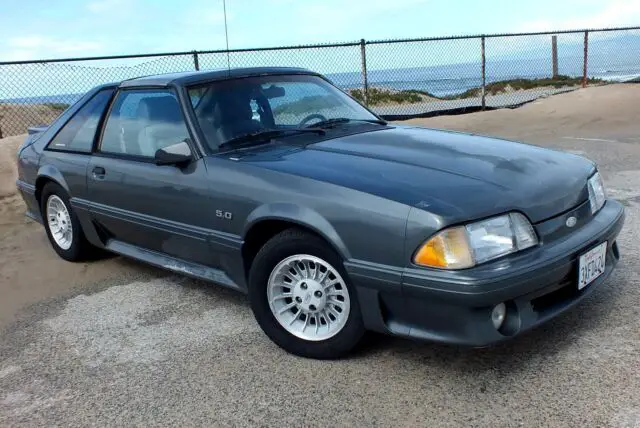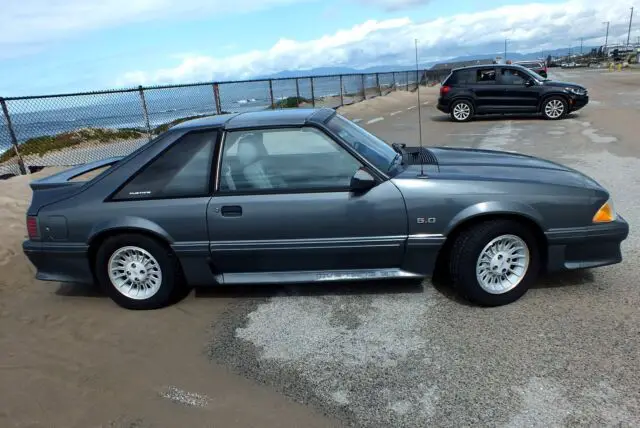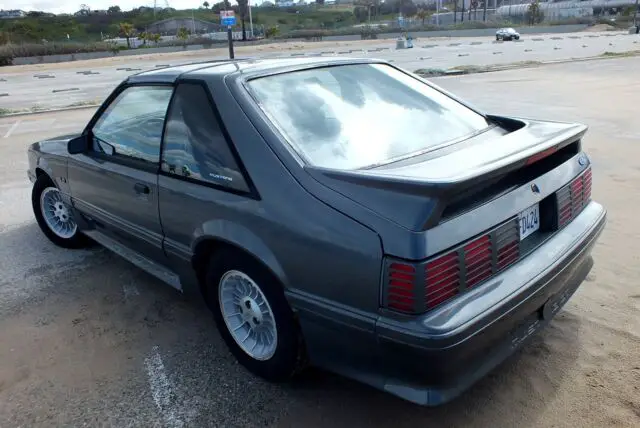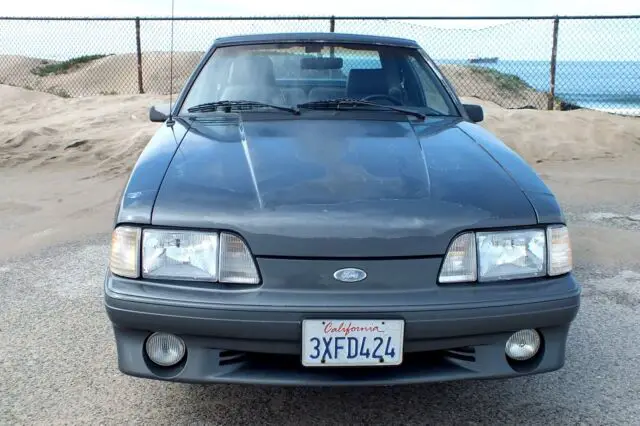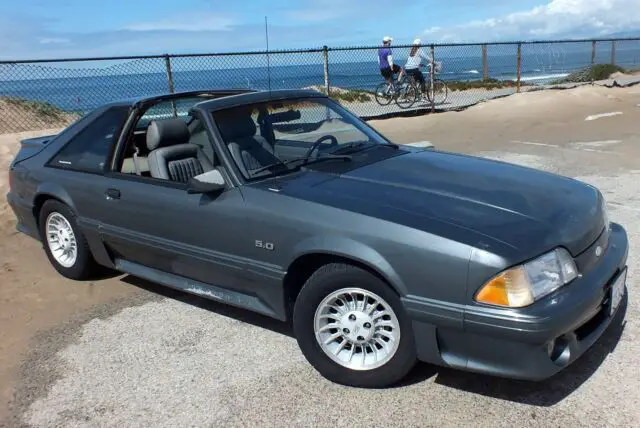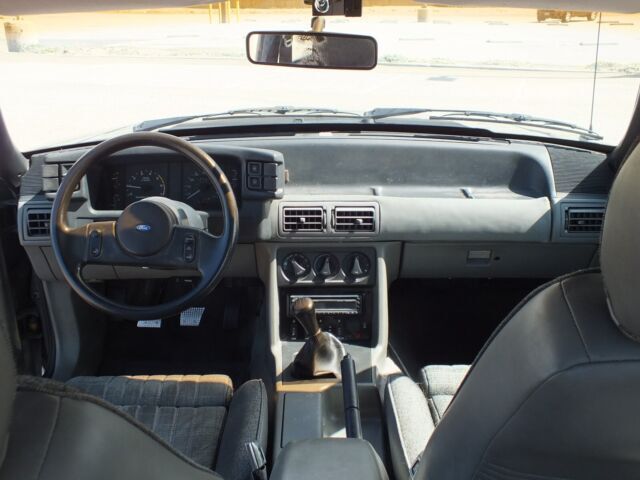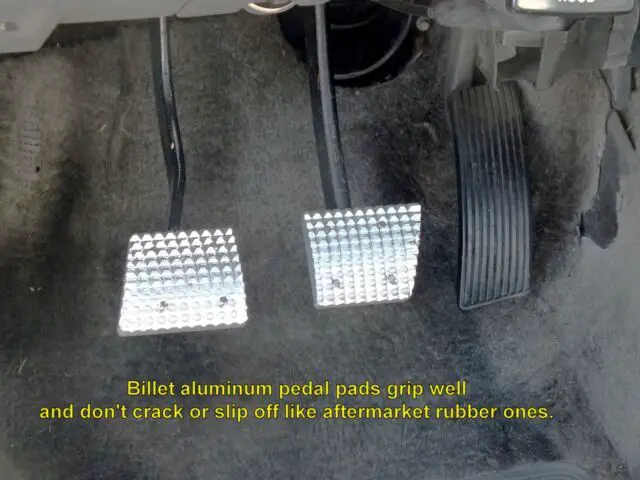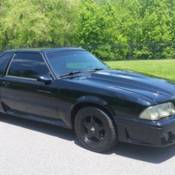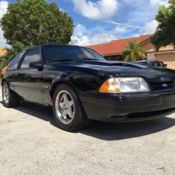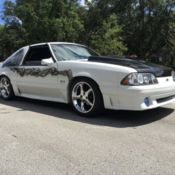1987 Ford Mustang GT Hatchback 2-Door 5.0L with T-top
1987 Ford Mustang T-Top
I'm the original owner and special ordered this Mustang GT through Don Kott Ford (Carson, CA), taking delivery in Feb 1987. I'm a non-smoker who's selling it in part due to a medical condition that makes clutch use problematic. As an avid DIY-type with an engineering background, I've done all maintenance and repairs myself. The ideal buyer would be a like-minded gearhead who could appreciate and benefit from the included parts, special tooling and documentation. Aside from 2 years in Northern Virginia, this car has called Torrance, CA home for the rest of its 36 years. It's been a really reliable car, and needed it's only tow last year when the distributor sensor wore out from vibration and touched moving parts. My descriptions are long-winded mainly because if I were a buyer, I would want to know this stuff and as a seller, I believe in honesty as the best policy.This Mustang GT came with a naturally aspirated 5.0L (302 CID) Windsor V8, equipped with a roller cam, and factory rated at 225 HP with 300 lb-ft of torque. The engine features SEFI (sequential electronic fuel injection) yet has a minimum of sensors and emissions plumbing, which simplifies maintenance. e.g. The "speed/density" fuel metering system requires no air mass meter. Power is sent to the wheels thru a Borg-Warner T5OD 5-speed manual transmission and a limited-slip differential. It has easily passed every biannual CA smog inspection and is offered with a clean California title and the original owner’s manual.The factory 2-tone grey color scheme was featured in Ford's marketing literature, with a blue stripe and "lower titanium" (silver) paint below the side molding. It was repainted in 1997 in a single color using a dark gray metallic similar to the OEM one. The car has been sheltered from daily sun exposure most of its life, so the original grey cloth upholstery is faring well. Standard equipment includes GT-specific body trim with 15″ turbine-style alloy wheels mounted with 225/60R15 tires, a handling suspension package featuring variable-rate springs and a quad-shock rear setup along with power-assisted rack-and-pinion steering. Braking is handled by power front discs and rear drums. Other equipment includes cruise control, a rear hatch spoiler, fog lights, front sport seats, a fixed antenna, and power locks. A custom 2" trailer hitch receiver is fitted with a paint-matched cover.Maintenance HistoryI have not kept great records of all fluids, maintenance and repairs, but I do have a log of all 1,258 fill-ups since the car was new. Despite using synthetic lubricants, the OEM engine started consuming oil at 150K miles so I replaced it with a stock rebuilt long block in 2007. At the same time, I had the transmission overhauled by Anaheim Gear (it was working fine). So, the body and rear end have seen 202K miles, but the engine and transmission could be said to have just 52K. At the time, I installed a Ford Racing clutch with a lot more clamping force than my stock engine needed. (Silly me!) This translated into unnecessarily high pedal pressure that made stop-&-go commuting a pain. A few years later, I replaced the clutch with a stock unit and had the flywheel resurfaced. I've made a number of small mods over the years, listed here in no particular order. The VIN is etched into all 8 windows, including the T-Top panels. A Jacobs ignition and high energy coil have been installed. The Jacobs control unit is hidden inside the left fender and the HEI coil is in the stock location. This system simply plugs into the stock coil connector to improve fuel economy slightly and provide an anti-theft feature. A standard 2” trailer hitch receiver was added with a 4-wire connector. Since the car has separate brake & turn lamps, an adapter module was added to combine these for the trailer. A Magnaflow cat-back dual exhaust improves the exhaust note without excessive noise. The stock self-adjusting clutch pedal linkage was never satisfactory and was replaced with a manually adjustable cable & quadrant, with a firewall adjustor for easy fine-tuning. The original series-wound starter was upgraded to the permanent magnet, gear reduction unit Ford used on the 1993 model. This provides improved performance at lower current drain. A battery float charger is installed behind the left headlight and works well to maintain the battery in storage. As mentioned elsewhere, the AC was retrofit from R12 to R134A in 1997. It has since been disconnected twice to replace the heater core and the last charge leaked down but was not refilled because I never use AC. The pressure switch on the accumulator has been disconnected to prevent rapid cycling of the compressor clutch from low system pressure. To reduce brake maintenance, I followed the U.S. Army and converted the service brakes from DOT3 to DOT5 silicone brake fluid. The proportioning valve was replaced at this time because it cannot be effectively flushed. While DOT5 has properties that make it incompatible with the ABS systems of today's cars, it does not attract water and has been a stellar performer in the Mustang, virtually eliminating the need for periodic flushing. I built and installed an idle air bypass spacer (similar to Ford F2PZ-9F939-A) under the ISC/BPA (idle speed control / bypass air) valve. This part reduces carbon fouling of the ISC by allowing a small but continuous air flow to inhibit EGR gas contact with the ISC. A filter has been added to the power steering return line (Cardone #20FLT2). The wiper arms are stock but the installed blades are thinner and use Trico 46-160 or 47-700 "Cut-to-Fit" Refills. If you replace the entire blade instead of just the rubber refill, this mod will go away. A thermowell was added to the thermostat housing to simplify coolant temperature monitoring. Smog check technicians may see that and get excited, but the original thermostat housing had no port in that location, although the casting was made for one. I tried LED backup lights but they seem no better than the stock bulbs.A USB power outlet for a GPS is present on the side of the instrument panel. The stock rubber pedal pads wore out but the available aftermarket replacements are all too soft (slip off or tear). I replaced them with billet aluminum pads that grip much better and never slip off. A ground wire was added to the rear hatch to solve issues with the rear window defogger because the hinges were unreliable in conducting electricity. Rocker switches by the hatch latch provide better control of interior lights. i.e. Disabling the switch is needed when carrying something too large to close the hatch. Disabling the rear cabin light is less important but has been handy at times. A switch was added to the dome light with the intent to add “OFF” and “ON” options to the standard “automatic” operation, although unswitched power has not yet been connected. Switched accessory power to the overhead compass & radar detector remains after these devices were removed. The stock audio system was Ford's "premium sound" but the factory radio failed. Its companion power amplifier had a proprietary interface so both were replaced with a generic AM/FM/CD radio. The CD has not been used in years and is presumed nonfunctional. The accessory control panel below the radio was added to replace the stock cubby.Over the years, many other parts have been replaced in the course of repairs. Here are the ones that come to mind, very roughly in chronological order: The TPS (Throttle Position Sensor) failed early on (symptom = very high idle) but was an easy fix. Retaining clips have been installed on the engine's fuel line connectors (per recall). The air conditioning was retrofitted in 1997 from R-12 to R-134A (new dryer & hoses) but has since leaked down and I chose to not refill it for environmental reasons so the AC is presently inoperative. I replaced the leaking stock radiator with a Modine brass unit. When the 2nd Modine radiator started leaking, I upgraded to an aluminum model that's electrically isolated from the chassis to reduce galvanic corrosion issues. I upgraded the front control arms with Ford Racing parts because I wanted their maintenance-free "lifetime" ball joints. The OEM X-pipe converter assembly was replaced with the OEM part because one of the 4 cats developed a rattle. I replaced the water pump many times before switching to an Edelbrock unit that's still doing well. The heater core has been replaced twice. The second leak was a fatigue crack at the solder joint caused from engine vibration transmitted thru short hoses. Since the dashboard has to be removed to access the heater core (a HUGE pain) I soldered some extra supports onto the last heater core which has mercifully held up well. The thermactor air pump has been replaced twice with reman units. The headlight capsules have been replaced several times (when the lenses got cloudy). The power steering rack, pump, and alternator have each been replaced once. The OEM fuel pump got flaky at 87K miles; it's replacement is still going strong. The original shocks & struts were shot at 90K miles, and I replaced them with excellent KYB units. I replaced the KYB ones on schedule at around 150K with Monroes (on sale), which have been OK for tire wear, but not so great for handling. I would definitely return to KYB next time. The EGR valve and its companion sensor have each been replaced once, but I had to grind the tip of the sensor down a bit so it would output the correct voltage. The service brake hoses have all been replaced at least once. The infamous TFI (Thick Film Integrated circuit) module and its companion Hall Effect sensor (both on the distributor) have been replaced twice. Each one failed at different times and I replaced them both as a set. Replacing the TFI is a snap, but swapping the sensor requires full disassembly of the distributor. The distributor cap and wires have been replaced at least once. Power door lock motors have each been replaced more than once. I have not mentioned obvious wear items like brake pads/shoes and rotors/drums.
WartsThis car has been my daily driver for 36 years, so there will certainly be a few warts; here is everything I can think of. The most visible one is the paint. Most of the paint is from 1997, but a minor parking lot bump to the fender required repainting the undamaged hood to match, and the clear coat here has totally failed. Other spots on the lower plastic trim are peeling. There is a bit of rust just starting at the base of the rear window and the bottom of the door skins on the inside edge. The black oxide coating on the mirror housings and some window trim has worn off. The reflective surface of the interior rear view mirror is oxidizing (splotches in the center). The speedometer needle has "always" wiggled since the car was new. The carpet has always fitted poorly @ passenger side of trans hump. The flex PCB in the instrument cluster can develop a bad connection that appears as an intermittent backlight or turn signal indicator, or the fuel gage dropping to E. This latter condition can be remedied by tapping the top of the dash cowling with your hand. The overhead map light switch fell apart and has not yet been replaced. I need to add a bit of coolant now and then. One possible cause of this was my use of silicone hi-vacuum grease on the hose fittings. This stuff seemed perfect at the time but has reacted with coolant and returned to its former life as silica beach sand. I just cleaned this from the upper hose at the radiator last month. The rear window defogger has a couple of broken strands but most still work. The trailer connector wiring may or may not conform to the industry standard pinout (verify before use). The seat belt retractor button door jamb bezels cracked from old age. Garden hose washers work great in this location but must be replaced every few years. The small underhood plastic vacuum lines to the HVAC controls and the TAB/TAD solenoid valves (emissions controls) are crumbling. These are easy to replace but I have not yet done that. The B.F. Goodrich Radial T/A's are 9 years old and not aging well despite 50% tread remaining so I would give them a C- rating. The clutch has a tendency to chatter which I manage with driving technique. The windshield washer pump failed many years ago, in part because I never used it. I have a new pump (included) but have not yet installed it. Likewise, I never use the AC and have not recharged that either. The instrument dimmer rheostat no longer works very well (needs cleaning).
Included ExtrasWhile in VA, I purchased a pair of stock aluminum wheels for use with seasonal snow tires, included. A number of other extras come with this vehicle that could prove valuable to a DIY owner. The documentation package includes a full factory Shop Manual and complete schematic Wiring Diagrams, as well as the Specifications handbook and Ford's DIY Maintenance Book. OBD-II systems first appeared in 1996 so this Mustang has an OBD-I system that Ford calls EEC-IV (for their 4th generation Electronic Engine Control). For diagnostics, it uses a proprietary code reader called a "STAR" Tester (Self-Test Automatic Readout), in mint condition and included. Advanced testing is made relatively simple with the Thexton ECU/PCU Breakout Box that enables monitoring of all electronic signals into or out of the Powertrain Control Unit (engine computer). A diagnostic test box (in photo of front passenger floor) brings 12V, 5V sensor power, and 2 underhood signals into the cabin for on-road testing. In 2007 when I replaced the engine, I built a lifting fixture that adapts a Harbor Freight load leveler to the factory lifting eyes on the engine. The adapter is included but the HFT load leveler is not (negotiable). A variety of spare parts are also included, such as belts, wiper blades, oil filters, lamps, etc. Lastly, the old X-pipe catalytic converter assembly is included. I held onto it in case I needed to fabricate a replacement some day, but a buyer could just as easily sell the cats for their precious metal content.On Jun-19-23 at 08:17:42 PDT, seller added the following information:
TermsThe preferred method for completion of sale is for the buyer to physically visit the seller. This will provide both parties with significant benefits in speed and security. Both parties would visit a local branch of the buyer’s bank for funding, at which time the seller will sign over title and release the vehicle. Seller is willing to accompany a CA buyer to a local DMV on request to officially complete title transfer. Due to widespread fraud, remote buyers have other options. eBay's escrow service is one option. Aside from that, the fastest payment is completed in 1-3 days via ACH or wire transfer. A physical cashier’s check is acceptable and will be verified by the issuing bank, preferably at a local branch. Personal checks are also acceptable but will incur a delay of 7-10 business days to fully clear. In any event, the signed title document will be sent via FedEx to the buyer within 1 business day of cleared payment. The buyer is responsible for transportation of the vehicle and included extras. Buyer should be aware that long-haul auto transporters may or may not accept goods stored within a vehicle. Seller will assist a local buyer in transporting extras within a 25-mile radius on request. If independent shipment (i.e. USPS, UPS or FedEx) of included documentation, tools, or parts is required, buyer will cover costs of packing and shipping by buyer's choice of shipper such as UPS Store or Box Bros. Any extras unwanted by the buyer will be disposed by seller. Seller will dismount at buyer's request the old Goodyear tires from the included 2 spare wheels.
- Make: Ford
- Model: Mustang
- Type: Hatchback
- Trim: T-Top
- Doors: 2
- Year: 1987
- Mileage: 202000
- VIN: 1FABP42EXHF130743
- Color: Gray
- Engine size: 5.0L
- Number of cylinders: 8
- Fuel: Gasoline
- Transmission: Manual
- Drive type: RWD
- Interior color: Gray
- Drive side: Left-Hand Drive
- Safety options: Back Seat Safety Belts, Fog Lights, Immobiliser
- Vehicle Title: Clean Want to buy? Contact seller!
